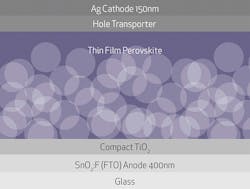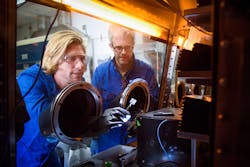Author:
Imagine a future when solar cells can be sprayed or printed onto the windows of skyscrapers or atop sports utility vehicles -- and at prices potentially far cheaper than today’s silicon-based panels.
It’s not as far-fetched it seems. Solar researchers and company executives think there’s a good chance the economics of the $42 billion industry will soon be disrupted by something called perovskites, a range of materials that can be used to harvest light when turned into a crystalline structure.
The hope is that perovskites, which can be mixed into liquid solutions and deposited on a range of surfaces, could play a crucial role in the expansion of solar energy applications with cells as efficient as those currently made with silicon. One British company aims to have a thin-film perovskite solar cell commercially available by the end of 2018.
“This is the front-runner of low-cost solar cell technologies,” said Hiroshi Segawa, a professor at the University of Tokyo who’s leading a five-year project funded by the Japanese government that groups together universities and companies such as Panasonic Corp. and Fujifilm Corp. to develop perovskite technology.
Not everyone is sold on perovskite as a game-changer from the industry’s heavy reliance on silicon photovoltaic cells. That said, recent research pointing to the material’s potential continues to grip the solar energy research community.
The World Economic Forum picked the material as one of its top 10 emerging technologies of 2016. Meanwhile, solar panel makers and top universities in Europe, the U.S. and Asia are racing to commercialize the technology, with researchers churning out as many as 1,500 papers a year on the material.
Momentum Builds
Perovskite’s usefulness was first hinted at back in 2006 when Tsutomu Miyasaka, a professor at Toin University of Yokohama, was approached by a graduate student interested in testing how well the material could convert sunlight to electricity. Though he’d been testing a number of different materials for solar panels, the Japanese academic had never heard of the synthesized crystal, Miyasaka said in an interview.
The idea to use perovskite, which is based on the same structure as a mineral named after Russian mineralogist Lev Perovski, initially went nowhere. Its structure was poorly understood and the industry had already latched on to silicon as the best material to convert sunlight into electricity.
Silicon solar cells have been around since the early days of the space program and now dominate the industry, with global shipments of solar products expected to have totaled $41.9 billion in 2016, according to market researcher IHS Markit. But they have limitations. For one, tremendous amounts of energy are needed to produce the silicon in solar cells.
Things began to change for perovskite with the first publication of research on the material by Miyasaka’s group in the Journal of the American Chemical Society in 2009.
“We had been turned down by magazines like Nature and Science and I suspect that’s because it was low in efficiency and also the material was unheard of,” Miyasaka said. “We talked about perovskite on many occasions but there was no feedback. Ninety-nine% of people didn’t understand the structure of perovskite and they decided to ignore it.”
Perovskite Solar Cell Composition
Efficiency Gains
Since then, the buzz has grown, thanks to research showing perovskite can convert sunlight more efficiently than initially thought. The big breakthrough came in 2012 when the material’s conversion efficiency -- the portion of sunlight that can be converted into electricity -- rose above 10% for the first time.
Passing that threshold attracted the attention of researchers toiling away on different types of solar cells that were then yielding lower efficiency, according to Martin Green, a professor at the University of New South Wales who also studies perovskite.
The efficiency of perovskite cells has improved further -- exceeding 20% in the lab -- to reach a level that took silicon cells years to achieve. Though conventional solar cells are still more efficient at about 25%, they’ve been stuck at that level for about 15 years, according to the World Economic Forum.
“All of a sudden you got about 10,000 researchers switching over to this field overnight,” Green said.
The efficiency improvements keep coming. In December, engineers at Green’s University of New South Wales announced they achieved a record 12.1% efficiency rating on a cell measuring 16 square centimeters. That’s the highest efficiency on a large-size perovskite solar cell to date, according to the university’s website. Higher efficiency ratings have been reported on smaller surfaces.
In September, Ecole Politechnique Federale de Lausanne (EPFL) in Switzerland said their scientists achieved an efficiency rating of 21.6% by adding rubidium to improve stability. Panasonic, a Japanese maker of silicon-based solar panels, took part in the Swiss project.
Researchers at Stanford University and the University of Oxford wrote in October their technology obtained a 20.3% efficiency, according to the Science website. The gain was achieved by stacking two perovskite cells to capture low-energy and high-energy light waves.
Photo: L.A. Cicero/ Stanford University
Solar Walls
The advances have raised the possibility that perovskite cells could one day be placed on top of cars, windows, and walls. Oxford Photovoltaics Ltd., a spin-off from the University of Oxford, says it’s developing thin-film perovskite solar cells able to be printed directly onto silicon solar cells. In December, Oxford PV said it got 8.1 million pounds ($10 million) of additional funding from investors including Statoil ASA.
“We expect to have a product that meets industry requirements by the end of 2017,” Frank Averdung, chief executive officer at Oxford PV said by email. “Adding some time for qualification, certification and production, our first product could be commercially available towards the end of 2018.”
Challenges remain. For one, researchers must still come up with a way to ensure the material remains stable outdoors for long periods of time. Methods for painting the material on large surfaces must also be improved, said Masanori Iida, an official at the technology and design sector at Panasonic. “It is difficult to continuously make the coating even,” Iida said by email.
“Perovskites aren’t ready for prime time,” said Robert Armstrong, director of the Massachusetts Institute of Technology’s Energy Initiative. “They degrade too quickly,” he said, but added that progress is being made to make them more stable.
Others are also cautious about the commercial viability of this new solar technology. “It certainly is going to be more than five years and it could be never,” Green, the professor at the University of New South Wales, said, referring to how soon perovskite solar cells will be commercially available. “For any technology to be marketable, it has to be certified and the testing process could take time. You need someone to bankroll an operation to scale up to go into manufacturing.”












